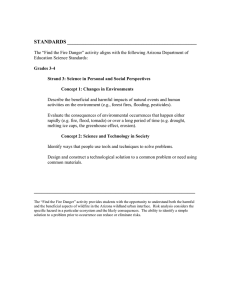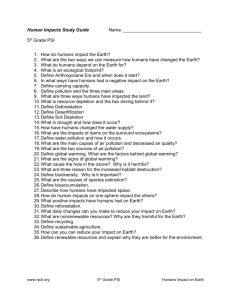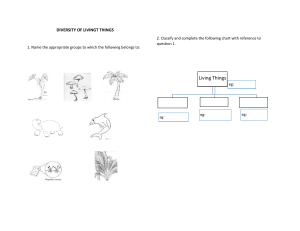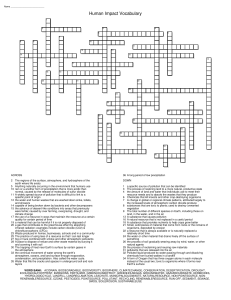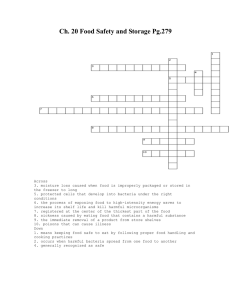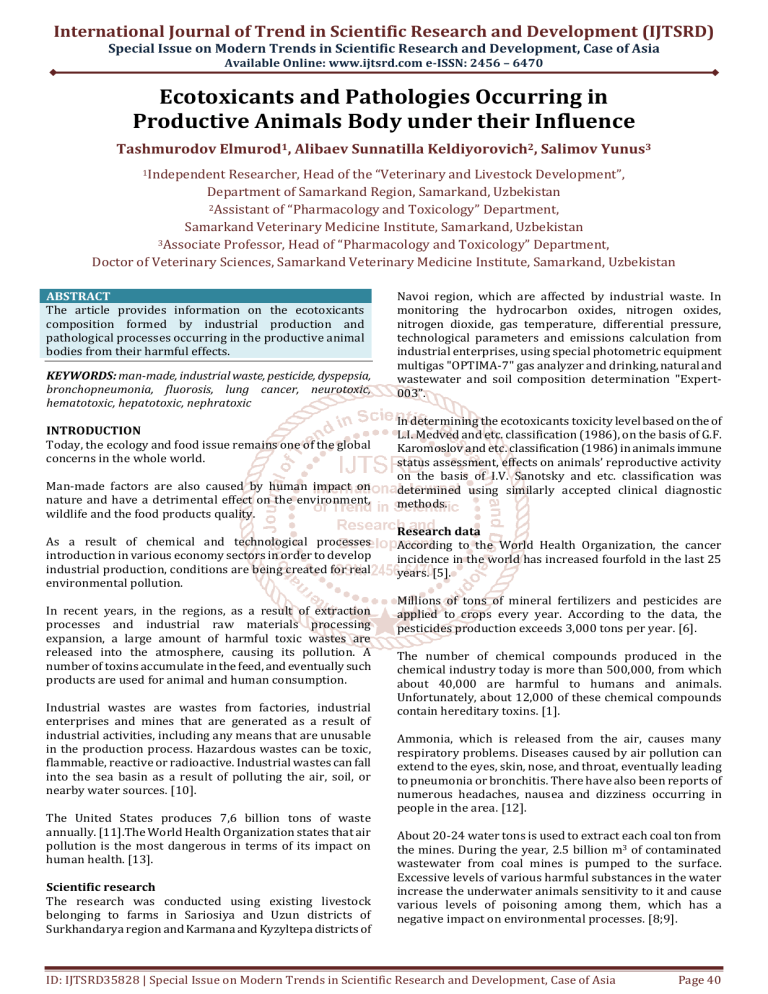
International Journal of Trend in Scientific Research and Development (IJTSRD)
Special Issue on Modern Trends in Scientific Research and Development, Case of Asia
Available Online: www.ijtsrd.com e-ISSN: 2456 – 6470
Ecotoxicants and Pathologies Occurring in
Productive Animals Body under their Influence
Tashmurodov Elmurod1, Alibaev Sunnatilla Keldiyorovich2, Salimov Yunus3
1Independent
Researcher, Head of the “Veterinary and Livestock Development”,
Department of Samarkand Region, Samarkand, Uzbekistan
2Assistant of “Pharmacology and Toxicology” Department,
Samarkand Veterinary Medicine Institute, Samarkand, Uzbekistan
3Associate Professor, Head of “Pharmacology and Toxicology” Department,
Doctor of Veterinary Sciences, Samarkand Veterinary Medicine Institute, Samarkand, Uzbekistan
ABSTRACT
The article provides information on the ecotoxicants
composition formed by industrial production and
pathological processes occurring in the productive animal
bodies from their harmful effects.
KEYWORDS: man-made, industrial waste, pesticide, dyspepsia,
bronchopneumonia, fluorosis, lung cancer, neurotoxic,
hematotoxic, hepatotoxic, nephratoxic
INTRODUCTION
Today, the ecology and food issue remains one of the global
concerns in the whole world.
Man-made factors are also caused by human impact on
nature and have a detrimental effect on the environment,
wildlife and the food products quality.
As a result of chemical and technological processes
introduction in various economy sectors in order to develop
industrial production, conditions are being created for real
environmental pollution.
In recent years, in the regions, as a result of extraction
processes and industrial raw materials processing
expansion, a large amount of harmful toxic wastes are
released into the atmosphere, causing its pollution. A
number of toxins accumulate in the feed, and eventually such
products are used for animal and human consumption.
Industrial wastes are wastes from factories, industrial
enterprises and mines that are generated as a result of
industrial activities, including any means that are unusable
in the production process. Hazardous wastes can be toxic,
flammable, reactive or radioactive. Industrial wastes can fall
into the sea basin as a result of polluting the air, soil, or
nearby water sources. [10].
The United States produces 7,6 billion tons of waste
annually. [11].The World Health Organization states that air
pollution is the most dangerous in terms of its impact on
human health. [13].
Scientific research
The research was conducted using existing livestock
belonging to farms in Sariosiya and Uzun districts of
Surkhandarya region and Karmana and Kyzyltepa districts of
Navoi region, which are affected by industrial waste. In
monitoring the hydrocarbon oxides, nitrogen oxides,
nitrogen dioxide, gas temperature, differential pressure,
technological parameters and emissions calculation from
industrial enterprises, using special photometric equipment
multigas "OPTIMA-7" gas analyzer and drinking, natural and
wastewater and soil composition determination "Expert003”.
In determining the ecotoxicants toxicity level based on the of
L.I. Medved and etc. classification (1986), on the basis of G.F.
Karomoslov and etc. classification (1986) in animals immune
status assessment, effects on animals’ reproductive activity
on the basis of I.V. Sanotsky and etc. classification was
determined using similarly accepted clinical diagnostic
methods.
Research data
According to the World Health Organization, the cancer
incidence in the world has increased fourfold in the last 25
years. [5].
Millions of tons of mineral fertilizers and pesticides are
applied to crops every year. According to the data, the
pesticides production exceeds 3,000 tons per year. [6].
The number of chemical compounds produced in the
chemical industry today is more than 500,000, from which
about 40,000 are harmful to humans and animals.
Unfortunately, about 12,000 of these chemical compounds
contain hereditary toxins. [1].
Ammonia, which is released from the air, causes many
respiratory problems. Diseases caused by air pollution can
extend to the eyes, skin, nose, and throat, eventually leading
to pneumonia or bronchitis. There have also been reports of
numerous headaches, nausea and dizziness occurring in
people in the area. [12].
About 20-24 water tons is used to extract each coal ton from
the mines. During the year, 2.5 billion m3 of contaminated
wastewater from coal mines is pumped to the surface.
Excessive levels of various harmful substances in the water
increase the underwater animals sensitivity to it and cause
various levels of poisoning among them, which has a
negative impact on environmental processes. [8;9].
ID: IJTSRD35828 | Special Issue on Modern Trends in Scientific Research and Development, Case of Asia
Page 40
International Journal of Trend in Scientific Research and Development (IJTSRD) @ www.ijtsrd.com eISSN: 2456-6470
Water pollution can have dangerous effects on the human
body. The main ones are diseases transmitted by bacteria,
parasites and chemicals. Because by drinking safe water,
people are protected from diseases (plague or typhoid) that
they can suffer from. [14].
As a result of the Aral Sea drying up, the land salinity has
increased 10 times. As a result, this condition accelerated soil
erosion. Currently, about 2 billion land hectares are lost due
to erosion. [2].
The total atmosphere pollution with harmful modern manmade factors is 4 billion tons, of which the main pollutants
are aerosols and gases, and 300-500 million tons are harmful
dust. [7].
The main sources of anthropogenic emissions into the
atmosphere are thermal energy and industrial producers, oil
and gas refineries and vehicles.
Sulfur and nitrogen oxides, which are industrial wastes, can
be stored in the atmosphere for up to 15 days, during which
time they can be blown away by winds up to 1,000 km. In
this case, one state can become a constant pollution source
for another state.
At present, air pollution is caused by fuel emissions from
vehicles. There are 1 billion cars in the world, and their
exhaust gases contain about 500 organic, toxic compounds,
40 of which have carcinogenic and mutagenic effects on the
body. [1].
Heavy metals are also one of the most polluting factors in the
atmosphere. The damage is mainly caused by cadmium, zinc,
cuprum and various wastes burning in furnaces. The plant,
which has a capacity of 1 million thermal energy kilowatts,
emits 1 kg of mercury and 0.1 kg of arsenium lead to the
atmosphere from burning about 1,000 tons of coal per day.
[3].
In the end, all these harmful substances accumulate in the
biosphere, and then they enter the humans and animals’
body through food, drinking water and air, causing various
diseases. Because these substances have neurotoxic,
hematotoxic, hepatotoxic, nephratoxic and respiratory
traumatic effects that are harmful to the body.
A number of harmful wastes emitted from industrial enterprises and their effects on the body, as well as toxicity and
danger level.
Table 1
Name of
The norm
Manipulation
harmful waste
Nitrogen
1
0,39 mg/l
Causes acute and chronic poisoning in the body. As a result, the hemoglobin
ammonia
amount in the blood decreases, leading to an increase in the methemoglobin
Nitrogen
amount. Oxygen deficiency occurs in the animal's body. It also reduces fetal
2
9,1 mg/l
nitrates
growth and development in pregnant animals. It belongs to III class in toxicity
Nitrogen
and danger terms.
3
0,02 mg/l
nitrite
Induces acute poisoning. The eyes and respiratory system are injured. Pain,
4
Ammonia
0,046 g/s
swelling and burning of the skin are observed. It belongs to IV class in toxicity
and danger terms.
In water 0,7-1,5 Fluorosis in the body (disrupts the minerals, carbohydrates and proteins
mg/l
metabolism in the body's enzyme system) leads to disease, as well as
5
Fluorine
20 mg/kg in
osteomyelitis, infertility, lung tumors, skin burns, necrosis, and disrupts
coarse feed
calcium metabolism. I class
It has strong poisons and dangerous effects. It has reproductive activity,
Hydrogen
In the air 0,1
6
ganadotoxic and embryotoxic effects, cumulative properties and mutagenic
fluoride
mg/m3
effects. It belongs to the I class on toxicity and danger level.
Disrupts the central nervous system and blood-producing organs activity in
Sulfur dioxide
0,1 mg/l
the body. Causes swelling and asphyxia in the lungs. It belongs to II class in
7
toxicity and danger terms.
Causes acute and chronic poisoning. Causes an increase in the methemoglobin
8
Nitric oxide
0,005 mg/l
amount in the blood. Pain, nephrosis, and liver dysfunction are observed. It
belongs to II class in toxicity and danger terms.
Causes acute poisoning in the body. As a result, the central nervous system
Carbon
In the air 0.019
disorders occur. It has an embrotoxic, toxic effect on the fetus. It belongs to IV
monoxide
0.9 mg/m3
class in toxicity and danger terms.
It carries and spreads germs and worms’ eggs. As a result of exposure causes
0,062
10 Inorganic dusts
bronchitis, conjunctivitis, dermatitis, allergies, poisoning, oncological diseases
g/s
in the body. It belongs to III class in terms of toxicity and danger.
ID: IJTSRD35828 | Special Issue on Modern Trends in Scientific Research and Development, Case of Asia
Page 41
International Journal of Trend in Scientific Research and Development (IJTSRD) @ www.ijtsrd.com eISSN: 2456-6470
Mineralization processes caused by water pollution and its impact on the body.
Table 2
Harmful substances
The norm
Manipulation
in water
1
Cuprum ions
0,001 mg/l After ingestion, severe abdominal pain occurs, manifesting cases of
tachycardia, asphyxia, paralysis, hemolysis in the blood, renal failure,
1,0
2
Cuprum
jaundice and allergies. It belongs to II class in terms of toxicity and danger.
mkg/l
The process of
1000
3
It leads to metabolic processes disruption in the body.
mineralization of water
mg/l
Disrupts the central nervous system activity in the body. Causes allergies
in 0.001
4
Phenol
and cancer. Deficiencies occur in the kidneys. It belongs to III class in
mg/l water
terms of toxicity and danger.
in 100 mg/l Disrupts metabolism and liver function. Reduces sexual activity
5
Sulfate
water
(ganodotoxic). It belongs to IV class in toxicity and danger terms.
Conclusions and conclusions.
Most of the chemical toxicants enter the body through the respiratory tract, gastrointestinal tract, skin and mucous
membranes. In high amounts, these chemical wastes and harmful dusts can have negative effects on the livestock and poultry
bodies, such as carcinogenic, teratogenic, embryotoxic and allergic.
As a result, it causes various pathological processes in the body. In particular:
1. The nervous system diseases (neurosis)
2. The digestive system diseases (dyspepsia, atony, tympani, gastroenteritis)
3. The respiratory system diseases (lung cancer, bronchitis, pneumonia, bronchopneumonia, pleurisy, laryngitis)
4. Metabolic disorders (Fluorosis, hypovitaminosis A, liver and kidney disease, allergies, osteomalacia, dermatitis, oncological
diseases, mastitis, conjunctivitis)
5. Genital diseases (infertility, fetal developmental pathology, testicular hernia)
6. Poisoning (pesticides, chemical fertilizers)
7. Parasitic diseases (coccidiosis, hemosporidiosis, fasciolosis)
8. Hereditary diseases (disability)
As an exposure result to chemical toxicants, various pathological processes occur in the animals’ immune system and
reproductive activity. In particular, their immunodepressive effect on the immune system leads to a decrease in overall
resistance in the body and an increase in local animals susceptibility to infectious diseases. [4].
In animal reproductive activity, a decrease in fertility leads to the offspring death in the next developmental period, barnyard
and infertility among females, and diseases such as testicular hernia in males. [6].
Chemical toxicants are the main organs that accumulate in the animals body: liver, spleen, heart muscle, kidneys, lungs, adipose
tissue, muscle tissue, tooth and bone tissue, blood, mammary glands and stomach mass. [4].
Decreases in the protein, carotene, phosphorus, reserves of alkalis and calcium amount required for the animal body due to the
harmful industrial wastes impact, naturally have a negative impact on animal productivity and the products quality derived
from them.
Conclusions
1. The continuous movement interdependence of hazardous industrial wastes in the external environment can be described
as follows:
ID: IJTSRD35828 | Special Issue on Modern Trends in Scientific Research and Development, Case of Asia
Page 42
International Journal of Trend in Scientific Research and Development (IJTSRD) @ www.ijtsrd.com eISSN: 2456-6470
2.
3.
4.
5.
6.
7.
Harmful waste leads to fluorosis, osteomalacia, hereditary diseases, nervous system, respiratory system, digestive diseases
and metabolic disorders, the reproductive organs diseases and poisoning among livestock.
Harmful chemical toxicants increase the animals susceptibility to infectious diseases, as a result of which the immune
system, from the immunodepressive effect, decreases the overall resistance in the body.
Decreased fertility in the animals reproductive activity leads to infertility and infertility among females, and to the diseases
occurrence such as testicular hernia in males.
As a result of water contamination with various wastes, its high mineralization level leads to metabolic disruption
processes in the animals’ body. To eliminate such cases, it is advisable to use EWTU (electrochemical water treatment unit)
water electrochemical treatment equipment.
The treatment system creation based on modern technologies, which recycles industrial waste and gases, will create the
basis for the harmful effects elimination on the environment and its inhabitants organism.
Conducting regular, veterinary and sanitary control quality analysis of consumer goods produced in agriculture and animal
breeding ensures the various diseases prevention that occur among the population.
References
[1] Gildieva M. S. Mutagenic activity of ecotoxicants,
hereditary and sporadic carcinogenesis and its
correction. Tashkent, 2010.
[8]
Yunusov. Kh. B., Improving the technology of
electrochemical water purification from dissolved
organic substances // Advances in chemical
technology. - T. XXII. - 2008, №10 (90). - p. 58-60.
[2]
Iskandarova Sh. T. Zoning of the territories of the
Republic of Uzbekistan. Int. magazine of Uzbekistan.
Tashkent 2003. №6 – p 24-28.
[9]
[3]
Onushchenko G. G. Some aspects of health and
environmental protection in the development of the
draft environmental doctrine in Russia. Healthcare of
the Russian Federation. М-2002. N2-P3-8.
Yunusov H. B., Polikarpova L. V., Droganova T.S.
Influence of pollution of the aquatic environment on
changes in the enzymatic activity of the freshwater
mollusk river live-bearer // AgroEkoInfo, №4. 2016.
[10]
Maczulak, Anne Elizabeth (2010). Pollution: Treating
Environmental Toxins. New York: Infobase
Publishing. p. 120. ISBN 9781438126333.
[11]
"Industrial Waste Management: Waste Stream
Statistics". Recover Inc. 2017-02-28. Retrieved 201904-23.
[12]
Society, National Geographic (2011-04-04). "Air
pollution". National
Geographic
Society.
Retrieved 2019-04-16.
[13]
Roser, Max; Ritchie, Hannah (2017-04-17). "Air
Pollution". Our World in Data.
[14]
Roser, Max; Ritchie, Hannah (2017-04-17). "Air
Pollution". Our World in Data.
[15]
Denchak, Melissa (2018-05-14). "Water Pollution:
Everything You Need to Know". Our Stories. New
York: Natural Resources Defense Council.
[4]
Khaitov V. R., Salimov Yu. and etc. Recommendations
for the prevention and treatment of immune
deficiencies in animals caused by chemicals.
Samarkand 2018.
[5]
Tursunov. Kh.T. "Fundamentals of Ecology and Nature
Protection". T. University 1997.
[6]
Khaitov V. R., Salimov Yu. and etc. Recommendations
on pathologies occurring in the reproductive organs
of animals under the influence of pesticides and other
chemical toxicants and measures to prevent them.
Samarkand 2019.
[7]
Yuldasheva.S. Sh, F. M. Jumaeva. The impact of
anthropogenic factors on the environment.
Republican scientific-practical conference. Tosh SAU,
2000.
ID: IJTSRD35828 | Special Issue on Modern Trends in Scientific Research and Development, Case of Asia
Page 43


